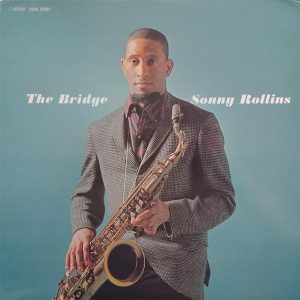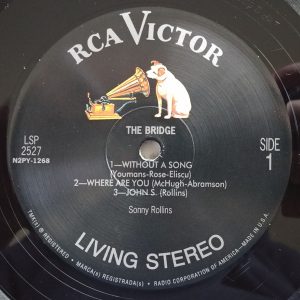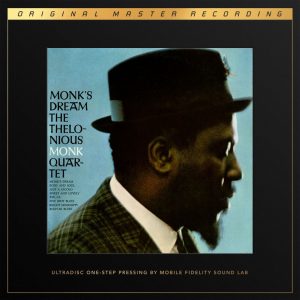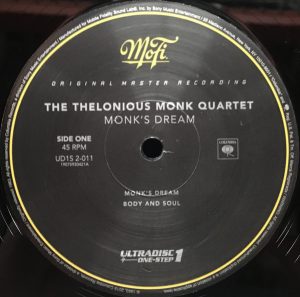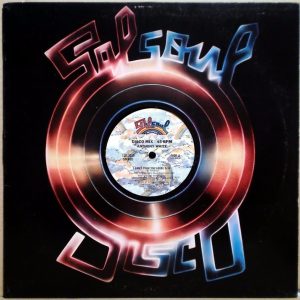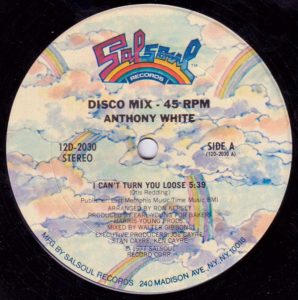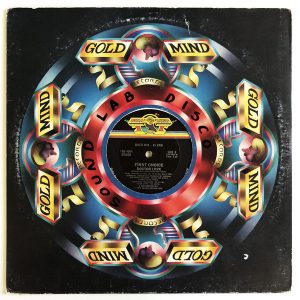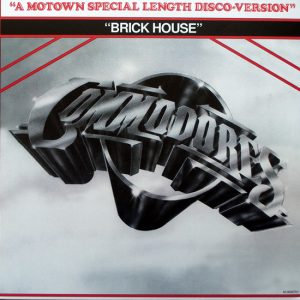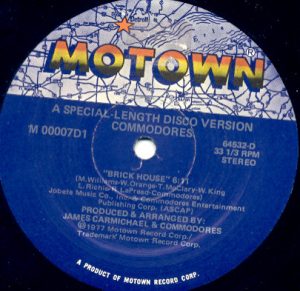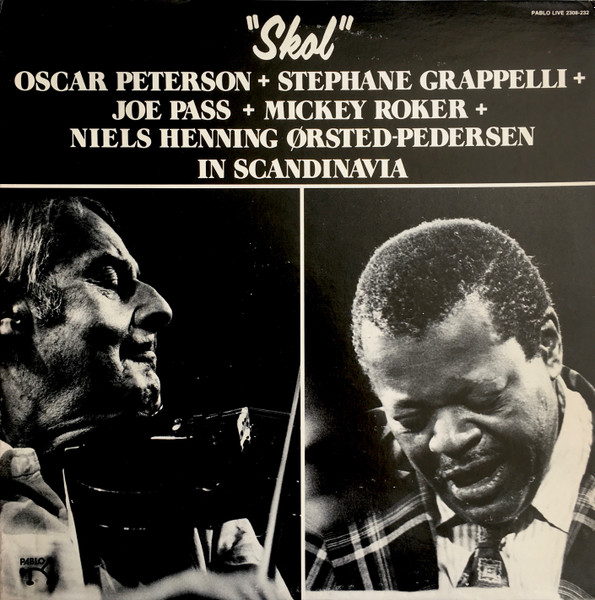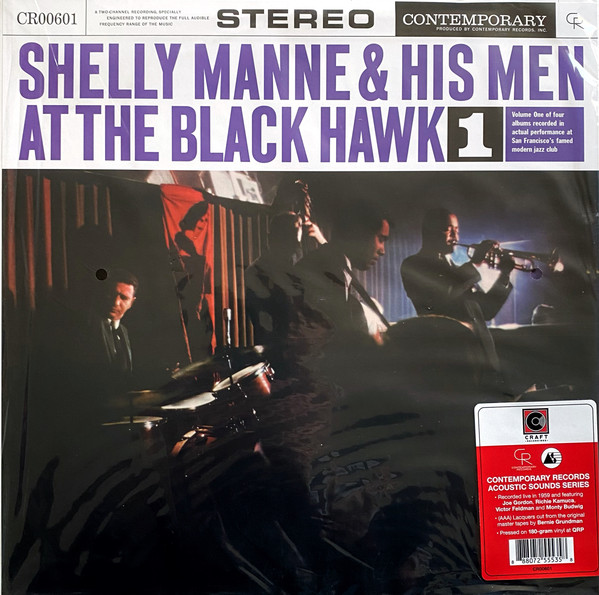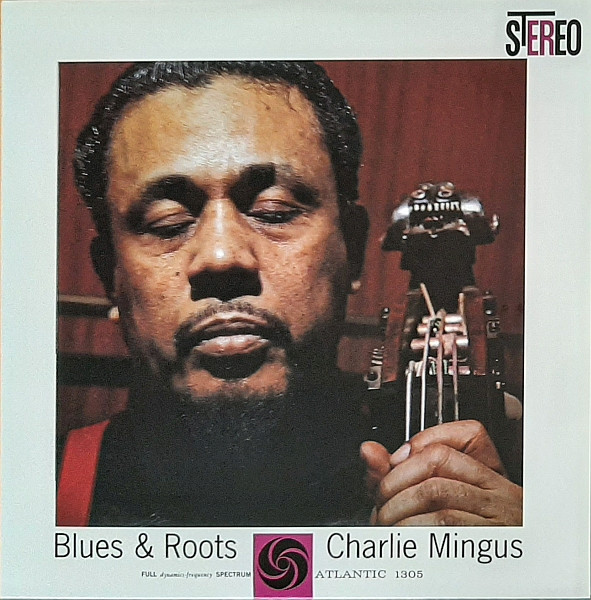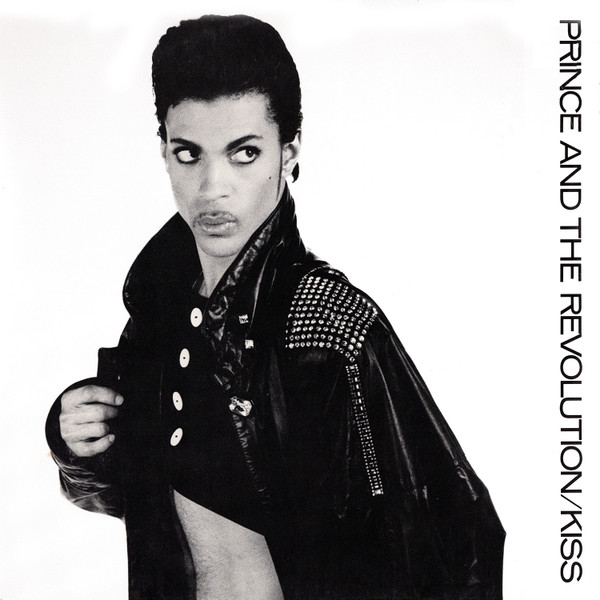This is an ongoing project by Claude Lemaire of Soundevaluations
136. Sonny Rollins, The Bridge. RCA – LSP-2527 (1962), Classic Records – LSP-2527 (1996), 33 1/3 rpm, 180g. Genre: jazz, hard bop.
Premiering with Prestige in 1953 with a couple of stops and stints at Blue Note, Contemporary, and Riverside, this was Rollins' first of six recordings for RCA—regarded highly from the mid 1950s through mid-1960s for their classical repertoire, but barely present in jazz territoire. After a brief recording recess lasting from mid-1959 to late 1961, he decided to dedicate his time and energy to improve his art. The album's title refers to the Williamsburgh Bridge in New York where "Newk" would go practice his sax year-round for hours on end, and what would be considered his "comeback" on the jazz scene. On this January and February 1962 occasion, Sonny is accompanied by bassist Bob Cranshaw, guitarist Jim Hall, and drummers Ben Riley and Harry "H.T." Saunders—the latter replacing Riley solely for the fifth track. Bob Prince produced the six track LP at RCA Victor Studios in New York with Ray Hall handling the engineering. This is certainly not the tenor's most adventurous material on wax—the first two tracks seemingly smooth—but he, along with the quartet, take it up quite a notch starting with "John S." followed by the title track opening the second side. The album has since been recognized as one of the artist's classics. Though the two leads often play in unison and are well captured, there is a bit of distortion around the guitar-amp combination that I'm unsure if it was intended or an artifact of the recording chain. The soundstage is nicely spread with Hall's guitar on the left, Sonny at opposite ends on the right—both up front—and the drums and bass reside solid center further back. RCA and Rollins' sax sound is warm, fine, and balanced but it does not spill overboard or come out and grab you like some of his previous Prestige and Contemporary offerings. Cranshaw's bass is generous and rather roundish for this era which is pleasant, yet is not as articulated to the fullest degree. Strangely it is the dynamic drumset that is superbly captured on tape, with one of the most natural snare sounds and realism I've heard. The interplay within the quartet in the form of the classic call and response found in some places is skillfully executed. I did not have an original RCA Living Stereo "DG white nipper" pressing to compare with, but Bernie Grundman did a superb remastering and cutting, first on 180g—the one I have—and later on 200g in 2000; both times for Classic Records and pressed by RTI in California. I did not hear the latter—though I usually prefer the 180g versions—nor could I compare the rarer four record, single-sided 45rpm edition [Classic Records LSP 2527-45S] which technically should surpass the regular version at leasts in top end extension, all else being equal. The tonal balance is wide, close to neutral with just a hint of bass lift, and overall warmth—whereas I speculate an original RCA would probably be more mid prominent, and less full range. Bernie later did a cut for ORG Music, pressed by Pallas in 2013 [ORGM1078], and there appears to be a second issue by ORG Music, pressed by Pallas in Germany in 2016 that has "BG / CB" in the matrix runout indicating that both Bernie and Chris Bellman collaborated together on this 180g reissue.
137. The Thelonious Monk Quartet, Monk's Dream. Columbia – CS 8765 (1963), MoFi – UD1S 2-011, Columbia 19075930421, Box Set (2019), (2x45 rpm). # P001. Genre: jazz.
Releasing fourteen albums for the label in five years, Monk's Dream marked his Columbia debut. As such, it shares some of the same production personnel and technical facilities as Davis and Brubeck on their landmark albums. Producer extraordinaire Teo Macero and Columbia's 30th Street Studio in Manhattan, NYC are the main ingredients in the winning recipe linking these albums with engineer Frank Laico presiding as the kitchen chef—all part of Columbia's coveted A-list. Joining him for the sessions are Charlie Rouse on tenor sax, John Ore on bass, and Frankie Dunlop on drums. Recorded between October and November 1962, the sound is to die for. Santana's Abraxas was spectacular, and Bill Evans' SATVV was also quite impressive, while Marvin Gaye's WGO was the most refined, and perhaps sonically the best of the UD1S boxes previoulsy released—Monk's Dream is at least its equal, or even surpasses them all! The sound of his Steinway is the most convincing I have heard on record—the sheer force of the hammers striking the strings, resonates. It is cleaner, less distorted, more stable, better articulated than anything I've ever heard, save for a true live close up performance. Of major importance is its even tonal balance, acoustic power, presence, and physical scale. All four sides are equal in musicality and sound quality. In that context, it is in the same league as my two prior Monk favorites: Brilliant Corners and Monk's Music (see 23 and 24 HERE regarding musical significance. To conclude, Mobile Fidelity's ninth UD1S—Monk's Dream—is the audiophile's ultimate dream come true. 'Master cutter' Krieg Wunderlich assisted by Shawn R. Britton outdo themselves once more. For a more detailed account, please go HERE.
138. Anthony White, "I Can't Turn You Loose"/"Block Party." Salsoul Records – 12D-2030 (1977), 12", 45 rpm. Genre: disco, Philly soul.
Although the Philadelphia singer registers a few releases on Discogs' data base between the mid 1970s and mid 1990s, Anthony White pretty much fits the "one-hit wonder" definition. And by "hit," not even a big one, nor an original one for that matter. On the contrary, his is a cover of Otis Redding's 1965 soul single "I Can't Turn You Loose" [Volt 45-130], which The Blues Brothers in 1978 reappropriated at a frenzied pace to introduce the comedic duo on stage during their live shows. White's version released in September 1977 is mostly known to disco dwellers and deejays of that same era, and is also cruising at an energetic 131 bpm or so tempo. Ron Kersey signed the arrangements while Joe, Ken, and Stan Cayre—the founding brothers of Salsoul Records—are credited as executive producers. Legendary deejay/remixer Walter Gibbons mixed it. Produced by drummer Earl Young for Baker-Harris-Young Productions—the famed Philly trio backing band powering countless classics fronted by The Trammps, MFSB, The Salsoul Orchestra, Double Exposure, and so many more–with its high octane intensity and soulful vocal delivery, it is definitely my favorite version of the three. In addition, side B's "Block Party" is as exciting as side A, for it is not a different song per say but rather an alternate instrumental version of the latter. Bolting out of the gate, Young—the inventor of the disco beat—startles us and our woofers with a solid, powerful punch in the stomach from his kick drum, followed immediately by countering with his cymbal, ushering in a captivating percussive intro peppered with syncopated snare/hi-hat shuffle patterns. Conga comes in, bass builds up the driving groove, keyboards, brass, strings, and guitar add on respectively. Around the 2/3 mark, the inverse occurs, i.e. we witness a breakdown or multi-track deconstruction, and then the true break features the conga and cowbell courting each other; after which the buildup starts over with the hi-hat, kick, bass, etc. The coda is particularly thrilling and interesting for it reprises the exact intro of side A's track, providing perfect passage to the latter if the deejay owns two copies in his collection—as I do—plus it's never a bad idea to have a backup in case of a mishap. Though not indicated, it was probably recorded at Sigma Sound Studios in Philadelphia. Al Brown mastered it at Frankford/Wayne Mastering Labs, New York. On both sides the sound is excellent, very well balanced from bottom to top with the vocals vs the music just in the right ratio regarding side A. Side B boasts tremendous bass punch and non-fatiguing, warm, well-panned mids and treble. Tight brass section shows appropriate crunch and definition; massed strings sound silky-esque; conga, snare, and percussion are percolating, taut, and snappy. Side B sounds a bit fatter and thicker tonally which is quite fun for the genre or club venue.
139. First Choice, "Doctor Love." Gold Mind Records – 12G-4004 (1977), 12", 45 rpm. Genre: disco, Philly soul.
Philadelphia's First Choice was one of the earliest collaborations between bassist Ronnie Baker and guitarist Norman Harris while working on the trio's first soul single—"This Is the House (Where Love Died)" [Scepter Records SCE 12347]–back in 1972; the same year as The Trammps first single—"Zing Went the String of My Heart" [Buddah Records BDA 306]. The next year saw the release of their debut album Armed and Extremely Dangerous [Philly Groove Records PG 1400] which included soulful disco classics "Smarty Pants," "Newsy Neighbors," as well as the title track. It was followed by 1974's The Player [Philly Groove Records PG 1502], and 1976's promo 12-inch single "First Choice Theme / Ain't He Bad" [Warner Bros. Records PRO 629]. Which brings us up to this 12-inch single released in May 1977 on Salsoul's subsidiary label Gold Mind, created the previous year by Harris for his productions. Not to be confused in any way with "Calling Doctor Love" by Kiss released just a few months earlier—"Doctor Love" remains my first choice when it comes to First Choice material, mainly for song and sound quality. Allan Felder, Ron Tyson, and Harris wrote the song. Arranged, conducted, and produced by Norman "The Harris Machine" Harris for Baker-Harris-Young Productions; like the previous selection, Joe, Ken, and Stan Cayre are credited as executive producers. Engineers Darrell Rodgers and Mike Tarsia—Joe Tarsia's son—recorded the track at Sigma Sound Studios in Philadelphia. This time, the one and only Tom Moulton mixed and mastered it, partnered as usual with José Rodriguez cutting the wax at Frankford/Wayne Mastering Labs, New York. Drummer Earl Young immediately grabs our attention by kicking things off with a cymbal strike on the "4" before the intro's "1" instead of on the "1" like the typical form found in disco. The original and uncommon instrumental 32-beat intro becomes a recurring theme a few times throughout the song. The soulful singing of Rochelle Fleming, Annette Guest, and Ursula Herring shares some similarities with Loleatta Holloway signed with Salsoul and Gold Mind. After a few verses and energetic choruses just before the '3 minute' mark, things tone down a notch during the extended jam-like instrumental break that follows the typical Salsoul Orchestra song structure, after which the chorus comes back to the fore at the very end 'til the tailgate fast fades out. The sound is excellently balanced, with good dynamic modulation for the genre. Interesting interplay between the brass and string section. Young's powerful snare snaps while his hi-hat has just the right sizzle be it on the quarter, eighth, or sixteenth-note pattern, and keep in mind this dude never drummed with a click track so we are talking mighty organic grooves all the way.
140. Commodores, "Brick House." Motown – M 00007D1 (1977), 12", 33 1/3 rpm. Genre: funk, funky disco.
Hailing from Tuskegee, Alabama, the Commodores started life as a funkified formation competing with the likes of Kool & the Gang, War, and Earth, Wind & Fire throughout the 1970s. Unbeknownst to many, they had a string of obscure funk singles starting in 1969 with "Rise Up"/"Keep On Dancing" [Atlantic 45-2633] until they hit the bulls-eye with "Machine Gun"—a funky disco instrumental top 40 hit from their debut album of the same name [Motown M6-798S1]. Beyond that, "Brick House" remains their biggest hit before they pivoted towards more chart topping, easy-listening ballads with lead singer Lionel Ritchie taking on more prominence, until his departure for a successful solo career in 1982. Incredibly, this track may have never seen the light of day, as the band, then fresh out of ideas, were still searching for a last song to complete their upcoming self-titled album scheduled for release at the end of March 1977. Produced and arranged by James Anthony Carmichael with the band, bassist Ronald LaPread jammed out the bass line foundation while the rest of the crew built up the house layers brick by brick. The song's lyrics were actually composed by trumpeter William King's wife—Shirley Hanna—after bringing a cassette copy of the tape to his home trying to find some lyrics to transform the track into a real song, and as they say, the rest is history. Engineers Cal "Blade" Harris and Jane Clark recorded and mixed the track at Motown Recording Studios in Hollywood, CA. Engineer Jack Andrews mastered and cut the album version but this 12-inch single is uncredited so it could be a different mastering and cutting engineer altogether. Whoever it was did an outstanding job. In effect the sound is as perfect as one could expect for this genre and probably one of the best sounding Motown maxi-single releases ever. Drummer Walter "Clyde" Orange opens the tune with a sneaky snare-tom-floor roll, one measure preceding the "1" of this classic syncopated funky beat highlighting kick, snare, and hi-hat combinations. The fat bouncy bass line establishes the groove. Crisp short staccato brass accent it. Finally Thomas McClary's clean guitar augmented by Clyde's chorus crystallize the catchy riff. Towards the end of the song there is a nice four measure long break comprising the metronome sounding snare doing the four-count, and permitting mix opportunity for deejays. The soundstage is quite wide with the drumkit panned accordingly. The six minute or so track along with the superb mastering and correct cutting level provides a strong, solid, enjoyable, modulating club-like bass with very low ear-fatigue even at high playback levels. The album version is nearly half the duration and is not exactly the same mix as found here, and will not be as sonically impressive neither, so stick with this 12-inch single release. Definitely reference caliber danceable material that you shouldn't be without.
For more from Claude Lemaire go to his blog...
http://soundevaluations.blogspot.ca/




